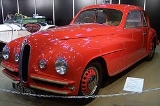
Bristol 401
Encyclopedia

Bristol 400
The Bristol 400 luxury car is the first automotive product of the British Bristol Aeroplane Company. After World War II, BAC decided to diversify and formed a car division, which would later be the Bristol Cars company in its own right...
.
Although mechanically the 401 and 402 used an improved version of the BMW
BMW
Bayerische Motoren Werke AG is a German automobile, motorcycle and engine manufacturing company founded in 1916. It also owns and produces the Mini marque, and is the parent company of Rolls-Royce Motor Cars. BMW produces motorcycles under BMW Motorrad and Husqvarna brands...
engine used in the 400, the styling was a huge advance on the pre-war bodies of that first Bristol model. It was inspired by the Milan
Milan
Milan is the second-largest city in Italy and the capital city of the region of Lombardy and of the province of Milan. The city proper has a population of about 1.3 million, while its urban area, roughly coinciding with its administrative province and the bordering Province of Monza and Brianza ,...
ese designer, Carrozzeria Touring
Carrozzeria Touring
Carrozzeria Touring is an automobile coachbuilder established on March 25, 1926 in Milan, Italy by Felice Bianchi Anderloni and Gaetano Ponzoni...
, and its most notable feature was that the door handles were not exposed and to open the doors the owner pressed a button into a groove in the door. The body also was more spacious than the 400 and was a full five-seater.
At the front the 401 and 402 were also quite distinctive with their headlights moved quite a distance into the centre of the body on either side of the narrow grille, which resembled BMW a little less than did the 400. They were also deeply curved at the front: this, along with the then-unique door handle arrangement, is believed to give the 401 a drag coefficient of less than Cd 0.36 — competitive even by today's standards and remarkable for the time.
The engine
Petrol engine
A petrol engine is an internal combustion engine with spark-ignition, designed to run on petrol and similar volatile fuels....
was the same 2 litre in-line six cylinder petrol unit of the 400, but was upgraded through improved Solex carburettors to increase power by 5 bhp to 85 bhp, which improved the performance further beyond what was achieved by the aerodynamics.
The suspension is independent at the front using a transverse leaf spring and wishbones and the rigid axle at the rear uses torsion bars. Steering is by rack and pinion. The brakes are Lockheed hydraulic with 11 in (279 mm) inch drums all round.
Although the 401's production figure of 611 is still the largest of any Bristol model, the 402 is regarded as one of the rarest classics among cars of its day. In a recent survey, 13 of the 23 produced could be accounted for.
A saloon tested by The Motor
The Motor (magazine)
The Motor was a British weekly car magazine founded on 28 January 1903....
magazine in 1952 had a top speed of 97.3 mph (156.6 km/h) and could accelerate from 0-60 mph (96.6 km/h) in 15.1 seconds. A fuel consumption of 20.8 mpgimp was recorded. The test car cost £3532 including taxes. Referring that road test in a subsequent ‘classic car’ feature, the journal summarised the 401 as a “Medium-sized car offering very high standards of comfort and performance”.

